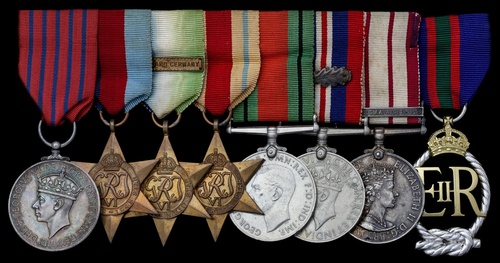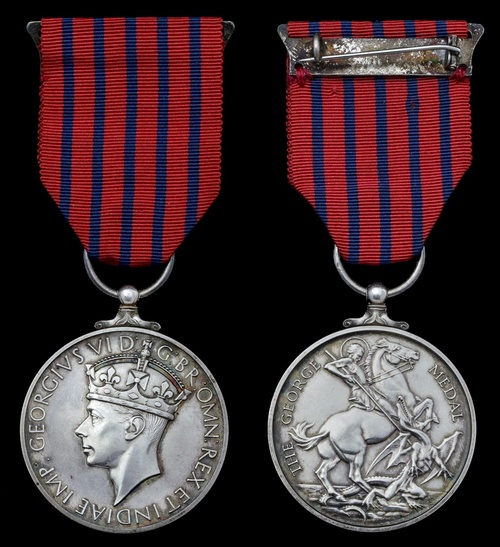Auction: 19003 - Orders, Decorations and Medals
Lot: 323
(x) An unusual Second World War 'double issue' G.M. group of eight awarded to Lieutenant-Commander P. C. Grant, Royal Naval Volunteer Reserve, late Riverboat Emergency Services, who received an immediate award for his exceptional part in rendering safe an enemy mine discovered beneath a hospital ship in Dieppe Harbour
As the port's Bomb Safety Officer, he took command of the perilous operation, employing a crane to lift the 'C' Type from waist-high mud to the quayside. Just how perilous became all too clear, for he discovered 'a small obstruction of substance had clogged the inlet holes to the pressure plate': one false move would have blown him - and his comrades - to Kingdom come
Remaining actively engaged in bomb and mine disposal work after the war, he added an Admiralty commendation to his accolades in August 1947, when he made safe a 1000lb bomb which had been dredged up off Southampton
George Medal, G.VI.R. (Lieut. Percy C. Grant. R.N.V.R.), together with its 'double issue', George Medal, G.VI.R. (Lieut. Percy Grant, R.N.V.R.), mounted on original wearing pin and in Royal Mint case of issue, extremely fine; 1939-45 Star; Atlantic Star, clasp, France and Germany; Africa Star; Defence and War Medals 1939-45, with M.I.D. oak leaf; Naval General Service 1915-62, 1 clasp, Bomb & Mine Clearance 1945-53 (Lt. Cdr. P. C. Grant. R.N.V.R.); Royal Naval Volunteer Reserve Officer's Decoration, reverse officially dated '1960', mounted as worn, excepting the second G.M., the clasp to the eighth being very scarce, very fine and better (9)
G.M. London Gazette 13 March 1945:
'For gallantry and undaunted devotion to duty.'
Percy Charles Grant was born on 14 January 1909, the son of Algernon Grant, a cheesemonger residing at 7 Grove Crescent Road, Stratford, London. Having worked as a shop assistant and window dresser during the 1930's, Percy served with the Riverboat Emergency Services in London in 1939 before entering the Royal Naval Volunteer Reserve as Probationary Temporary Sub. Lieutenant on 26 April 1940.
Posted to the Harwich shore base Badger - whose minesweepers were prominent in early efforts to find and destroy German magnetic mines - he was promoted Temporary Lieutenant on 26 July 1940 and appointed to a number of trawlers and destroyers for 'special duty', namely to acquire knowledge of the newly introduced German magnetic mine. Detonated by the invisible magnetic signature of steel ships - even when tens of metres away - the results could be catastrophic, underwater explosions having the ability to break ships' keels and breach submarine hulls. Furthermore, once a single mine had detonated, the possibility of more mines discouraged movement in the area and tied down considerable manpower and material reserves.
On 1 August 1942 Grant was placed in command of the controlled minelayer Snakefly and sent in early 1943 to the Coastal Forces Motor Launch Base Eland based at Freetown, Sierra Leone. As a major embarkation point for Atlantic convoys, Freetown held considerable strategic value for the allies, hence Snakefly set about the important task of maintaining port security in association with five anti-submarine trawlers, 15 Harbour Defence Motor Launches and the controlled mining and loop vessel Corbrae. In the eyes of the British Cabinet, the security of shipping routes off the West Coast of Africa, in particular the large volume of reinforcements and supplies for India, the Middle East and Eastern Mediterranean - much of which at that time was still routed via the Cape - made Freetown a vital port and a link of first importance in allied sea communications. Failure to hold Freetown and maintain safe passage through its channels would mean the use of the undefended harbour at Takoradi as a convoy assembly point, and likely considerably higher naval and merchant losses.
His orders accomplished, Grant returned home to the naval dockyard at Chatham on 3 February 1944 and was sent to the land-based 'top secret' training establishment, H.M.S. Volcano, on 5 March 1944. Based at Holmrook Hall in Cumbria - a Victorian country house which played host to author Lewis Carroll in peacetime - it was said that local people were fed the ruse that the building was a 'rest home' for shipwrecked and distressed sailors. It was nothing of the sort, rather having been requisitioned by the Admiralty at the outbreak of hostilities and, being strategically located between the Royal Ordnance Factories of Drigg and Sellafield, it was the perfect site for the Royal Navy bomb and munitions training school. Grant spent three months at Volcano before being transferred to Naval Party No. 1686 for bomb and mine disposal duties on 16 June 1944.
G.M. - deep mud and a hospital ship
The events leading up to the award of the George Medal to Grant - and his colleague Sub. Lieutenant Ronald Mervyn Orr - occurred at Dieppe on 12 October 1944, when an enemy mine was discovered lodged beneath a hospital ship. Grant's modest account of proceedings stated:
'At 11.20 a.m., the Army divers reported an object protruding 18 inches out of the mud and resembling the shape of a bomb. At 11.50, Sub. Lieutenant Orr dived to find that the object was a "C" Type mine, which was lying at an angle of 60 degrees. The usual precaution of clearing the area was taken, and for three hours an endeavour was made to remove the primer - which had approximately two feet of mud over it. This mud caused great inconvenience in trying to remove this primer, and during the process, one of the threads got crossed which made further efforts of removal practically impossible under the conditions experienced. It was discovered that a wooden bung was used in place of a bomb fuse.
It was then decided to lift the mine by the aid of a crane loaned by the B.S.O. The crane-driver was informed of the job he was undertaking and he volunteered to lift the mine by his crane. Sub. Lieutenant Orr then dived and made fast the non-magnetic shackle to the lifting lug of the mine. By this time, all shipping was clear of the danger area, and the diving boat was sent away to a safe distance. The mine was then lifted onto the quayside and rendered safe by the following procedure: A wooden bung was removed first. This was used in place of the fuse. The primer was then removed. In the effort of unscrewing the primer beneath water, a thread got crossed and this caused some difficulty in removing. Having removed the primer, the detonator was then removed. The clock was removed last and found to be a Mk. IV set for six days and had not started. Upon further investigation of the clock, it was discovered that a small obstruction of substance had clogged the inlet holes to the pressure plate. The unit was removed by remote control and found to be magnetic.
By 16.00 hours, the mine had been rendered completely safe and removed to demolition site. The unit, clock and primer have been retained in the Bomb Safety Officer's Store.'
(Signed) C. P. Grant. Lieutenant, R.N.V.R., Bomb Safety Officer.
In the Recommendation for Operational Awards from the Naval Officer-in-Charge, Dieppe, to The Flag Officer, British Assault Area, Rouen, the full extent of Grant's role was made clearer:
'I was personally present during the whole of the incident and consider that Lieutenant Grant, R.N.V.R. and Sub. Lieutenant Orr, R.N.V.R., showed exceptional capability and great devotion to duty in the rendering safe of this mine. Sub. Lieutenant Orr was under water almost continuously from 1150 until 1400. He was working up to his waist in mud, and when he had finally completed his work, came to the surface in an exhausted condition.
Lieutenant Grant was responsible for the lifting of the mine on to the quay - a very difficult and delicate operation, and for the final removal of the primer and rendering safe of the mine. These two officers, with the entire party, have done exceptional work at Dieppe, and it is very largely due to their efforts that work in the Port has proceeded so smoothly. In view of this, and the particularly dangerous incident cited above, I recommend that some suitable recognition be made of their services.'
Recommended for an 'immediate' award on 28 November 1944, the award of the George Medal to both men was approved on 21 February 1945 and confirmed by the Chairman of the Selection Committee at Treasury Chambers, Great George Street, S.W.1., London.
Promoted Temporary Acting Lieutenant-Commander on 31 March 1945 and Lieutenant-Commander on 14 January 1947, Grant was sent to H.M.S. Pubeck, the bomb and mine disposal unit at Studland, Dorset. It was here that he and Lieutenant H. T. Forge, R.N.V.R., were formally Commended by the Commander-in-Chief, Portsmouth, Admiral Lord Fraser for a 'risky' bomb disposal operation conducted in Southampton Water. The official Commendation states:
'For their courage and initiative in dealing with a 1000 lb. German bomb which was discovered in a dredger at Southampton on 19 August 1947. Since the bomb was too dangerous to be removed from the dredger, owing to the proximity of other shipping, it was taken to sea. The action of these officers reflects great credit on the Navy.'
This heroic deed - which was conducted throughout the night - is further described in an article published by the Cairns Post on 22 August 1947:
'You may guess what a shock we had when we saw our catch', said a member of the dredger crew.
'A navy bomb disposal squad are now trying to remove the fuse from the bomb which has its nose in the air and its tail firmly in the bucket.'
Transferred to the Permanent R.N.V.R. (London Gazette 20 August 1953, refers), he continued to be involved in bomb and mine disposal work throughout the 1950s at a variety of south coast shore bases, being finally placed on the Retired List on 14 January 1964.
Having received his first George Medal at an investiture on 3 July 1945, it is likely that a second was issued soon thereafter which included his correct middle initial. The London Gazette confirms that he did indeed have this middle initial; sold with extensive copied service record, award recommendations and research.
Subject to 5% tax on Hammer Price in addition to 20% VAT on Buyer’s Premium. For more information please view Terms and Conditions for Buyers.
Sold for
£7,500
Starting price
£4200







